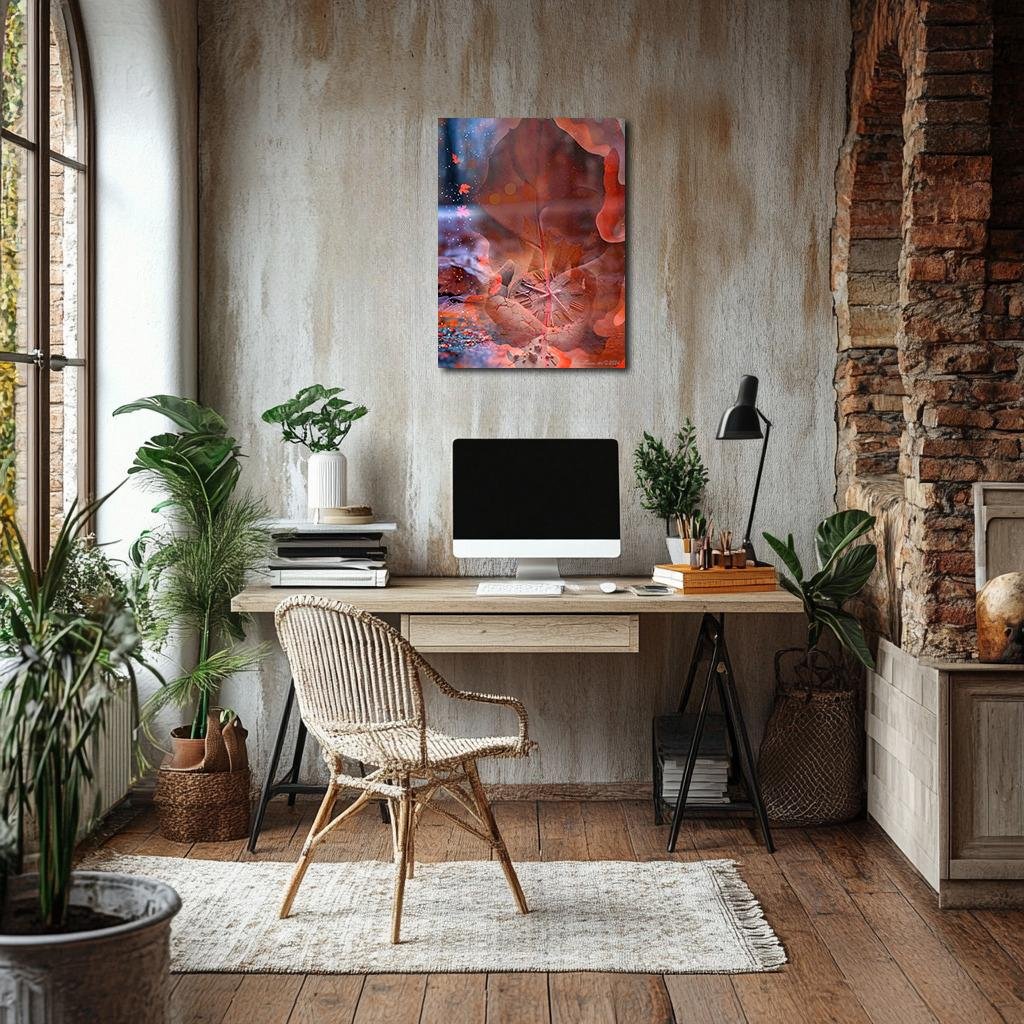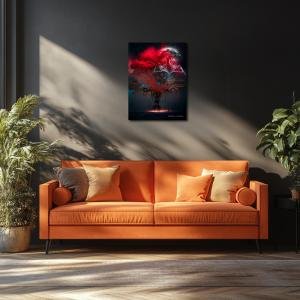Timefall: Autumn Leaf II
Timefall reimagines O’Keeffe’s Autumn Leaf II as a poetic meditation on the convergence of time and decay. A cracked clock is embedded in a single red-veined leaf, symbolizing the slow merging of memory and earth, mortality and cycle. Surrounded by spiraling leaves, mist, and soft light, the scene whispers of sacred transformation. Warm russet, burnt orange, and crimson tones mix with ghostly violets and cool fog, evoking both warmth and surrender. In this autumnal reverie, time does not pass—it settles into the soil, reminding us that all things fallen are still part of the eternal rhythm.
Please see Below for Details…
Hotline Order:
Mon - Fri: 07AM - 06PM
404-872-4663
Timefall reinterprets Georgia O’Keeffe’s Autumn Leaf II as a surreal meditation on time, decay, and eternal return. In this conceptual reimagination, the solitary fall leaf—once delicately celebrated for its fading beauty—is transformed into the beating heart of a cosmic clock. Set against a softly dissolving background of mist, shadow, and amber-toned ground, this piece fuses the organic quiet of autumn with the mechanical rhythm of time’s passing. O’Keeffe’s original attention to the curve and vein of the autumn leaf becomes, here, an entry point into something deeper: a reverie on cycles, on endings that echo beginnings, and on the sacred stillness that exists in the moment a leaf lets go.
The central form of the leaf is preserved—its sharp edges softened into translucency, and its network of veins merging with cracks on a buried watch dial. The clock is not loud or central—it is nestled within the leaf, half-buried in the ground, as if time itself is decomposing into soil. The leaf’s stem aligns like the clock’s hand, its red vein pulsing like the memory of life still warm. Around it, smaller leaves spiral downward in gentle flight, their descent frozen like snowflakes in the amber air. These leaves are suspended, not yet gone, their edges flickering with light, reminding us that even in falling, there is grace.
The composition’s palette is a careful blend of rust, rosewood, deep garnet, and soft sienna—warm, melancholic hues that cradle the idea of loss with reverence rather than despair. The reds are muted but rich, evoking the last burst of blood through a vein, or the final kiss of sun before dusk. Burnt oranges smear the background like faded fire, speaking to both heat and age. Browns drift toward ashy grays, suggesting the transformation of matter to memory. Within the leaf itself, these tones are magnified: the crimson spine pulses with quiet intensity, while the outer edges dissolve into dusty amber and faded ochre, like paper curling at the edges of flame.
Subtle purples and misty violets whisper through the background, carrying with them the chill of early frost and the poetry of twilight. These cool tones do not clash with the warmth but rather hold it, contrasting life’s glow with the inevitability of fading. A faint blue-gray fog drapes the horizon—cool, melancholic, and still—allowing the viewer to feel the slow hush of autumn’s hush.
Beneath the leaf-clock, the cracked surface of earth and stone emerges through thin layers of translucent shadow. The cracks echo veins, like an underground map of time’s root system. Time here does not tick—it settles, rests, disintegrates. The clock, weathered and fractured, becomes part of the leaf, and the leaf becomes part of the land. In this fusion lies the message: decay is not destruction; it is transformation. Time is not a linear line of losses, but a soft spiral, like the way leaves fall in circles and wind returns in seasons.
Floating throughout the image are tiny flecks of light—bokeh glimmers like fading stars, and small autumn leaves caught midair. They move softly, barely there, adding breath and rhythm to a scene that feels like it is suspended between heartbeat and stillness. These scattered lights recall memories—glowing, flickering, then vanishing into the wind.
In creating Timefall , I imagined O’Keeffe not as a still-life observer of decay but as a quiet philosopher of passage. Her deep respect for the natural world—its temporality, its sacred patterns—is preserved in this work, but here expanded into cosmic language. The leaf becomes not just a specimen, but a clock, a relic, a symbol of time’s sacred erosion. Where once we looked at the curve of a dying leaf and saw loss, this reinterpretation invites us to see continuity: how death curves back into life, how endings become soil, how time isn’t slipping away but transforming form.
This piece asks us to be still—not to rush past the season’s turning, but to sit with it. To listen. To recognize the holy sound of time’s breath falling with the leaves. It is not a mournful scene, but a sacred one—a chapel of turning, of remembering, of release. The leaf teaches us to let go, not with grief, but with grace.
Add your review
Your email address will not be published. Required fields are marked *
Please login to write review!
Looks like there are no reviews yet.








